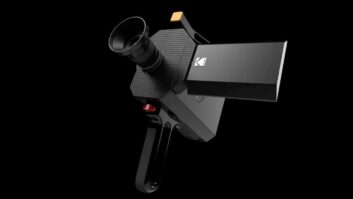In a show formerly marked by the pungent vapors of processing chemistry and row upon row of film boxes, PMA 2004 was a celebration of the mainstreaming of digital imaging technology.
Vendors looked to capitalize on yet another double-digit-growth year with more expansive product lineups than 2003. All the major vendors brought new models to the floor that stressed both improved camera performance — particularly in start-up times and shot-to-shot times — in addition to more robust movie modes, increased resolution, larger LCD screens and specialized scene modes that take the guess-work out of exposure control.
Predictably, consumers will get more megapixels for less in 2004 as many big-name manufacturers set aggressive new benchmarks to lure the entry-level consumer. Concord, for instance, introduced its 5-megapixel Eye-Q 5062 for a suggested retail of $229.
Casio introduced the EX-P600 Exilim Pro, a 6-megapixel model with a 4x optical zoom and a 2-inch LCD screen. It will ship in March for a suggested retail of $699.99. It sports PictBridge compatibility, 10MB of internal memory, 25 pre-set scene modes in addition to a 1.5-second start-up time and .01 second shutter lag.
Konica-Minolta introduced three new models under the DiMAGE brand.
The 4-megapixel DiMAGE Z2 features a 10x optical/4x digital zoom and rapid autofocusing. It is the company’s first digital camera to come equipped with the new Mega-zoom lens which features an all-glass apochromatic (APO) lens. The Z2 can record VGA movies at 30fps in addition to the industry’s first (as of this writing) 15fps SVGA (800 by 600) movie capture mode. All movies run to the capacity of the memory card. The Z2 will have a suggested retail of $449.
The 2-megapixel DiMAGE Xg builds on the thin design of the DiMAGE Xt and features a faster start-up time of approximately 0.8 seconds, a larger LCD monitor at 1.6 inches, a night movie mode and PictBridge compatibility. The camera also features a 3x optical/4x digital zoom lens and carries a $299 suggested retail.
Finally, the company announced a high-end, 8-megapixel fixed-lens model, the A2, offering a new 3D autofocusing system and proprietary Anti-Shake technology. The A2 will retail for a suggested $1,099.
Kyocera introduced a 4-megapixel model of its SL-series camera with RTUNE technology, the Finecam SL400R. The model features the same body and features as the 3-megapixel SL300R, including a 3x optical zoom lens, but adds a lens hood to protect the lens. It will ship in March for a suggested retail of $399.99.
Olympus jumped onboard the PictBridge wave, incorporating the direct-print standard across its entire digital camera lineup. The 2004 line will start with the entry-level D540, a 3-megapixel model with a 3x optical/3.3x digital zoom and 1.8-inch LCD screen, shipping in March for an estimated street price of $199.
The company updated its Stylus line of all-weather digital cameras with the 4-megapixel Stylus 410. The camera features a 1.5-inch LCD screen, 3x optical/4x digital zoom and a virtual mode dial. It will ship with a 32MB xD Picture Card in March for an estimated $399 street price.
At the top of the consumer line will be the C-8080, an 8-megapixel camera with a 5x optical zoom lens, a 1.8-inch articulating LCD screen and xD and Compact Flash card slots. The C-8080 will ship in March for a suggested $999.
Pentax introduced the OptioMX, the company’s first combination digital still/movie camera. The palm-sized OptioMX features 3.2-megapixel still image resolution and a 10x optical zoom lens. It captures MPEG-4 video at VGA resolution. The MX is expected to be priced under $400 and ship in June.
Samsung will target aggressive price points in 2004 as it continues courting mass market and specialty retailers with two distinct camera lines.
For the mass market, the company announced the 4-megapixel Digimax 430 featuring a 2.8x optical/4x digital zoom with an estimated street price of $229.99.
For specialty dealers, Samsung announced the 5-megapixel Digimax V50. The model features a 2.0-inch TFT LCD screen, continuous or AEB modes and MPEG-4 movie capture at 640 by 480 resolution at 30fps. It will have a suggested retail of $379.99.
Sony’s 2004 camera lineup will start at 4 megapixels at the entry-level and will incorporate Carl Zeiss lenses on more of the line. All models will feature the ability to capture MPEG movies at 30fps, in addition to PictBridge compatibility and USB 2.0 connectivity.
The SDC-P41 is a 4-megapixel, fixed-focal-length model with a 3x digital zoom. It will ship in May for a suggested $199.95.
The DSC-W1 is a 5-megapixel model with a 2.5-inch LCD screen for a suggested $399.95. The camera, shipping in June, sports a 3x optical/2x digital zoom lens and a nine-shot burst mode at 1.6fps.
The 5-megapixel P100 will also ship in May for a suggested $399.95. It features a 1.8-inch LCD screen, 3x optical/2x digital zoom, and the nine-shot burst mode.
Sony also announced a Cyber-shot Station, a USB docking station for the new Cyber-shots. The cradle will ship in May for a suggested $79.95.
World Wide Licenses announced the Polaroid-branded x530, the industry’s first point-and-shoot digital camera to incorporate the Foveon X3 direct image sensor.
For a suggested $399, the x530 sports a 3x optical/4x digital zoom, a 2-inch TFT LCD and 32MB of internal memory.
For more coverage of the PMA Show see the March 8 edition of TWICE.













